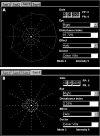Night vision disturbances after successful LASIK surgery
- PMID: 17314153
- PMCID: PMC1954826
- DOI: 10.1136/bjo.2006.110874
Night vision disturbances after successful LASIK surgery
Abstract
Objective: To evaluate the changes in correlations of higher order aberrations of the first corneal surface with halo phenomena, a form of image degradation, under night vision conditions measured objectively after successful LASIK (laser in situ keratomileusis) surgery.
Methods: A prospective, observational, analytical study of 110 eyes that had undergone successful LASIK surgery for myopia and astigmatism. Preoperative sphere was (mean (SD)) -3.48 (1.70) D (0 to -8.00 D) and preoperative cylinder was -0.86 (0.87) D (0 to -4.00 D). Visual disturbance caused by halo phenomena was measured with the Starlights v1.0, and pupil size was measured with Colvard pupilometry after adaptation to a dark environment (0.17 lux). Corneal aberrations were computed for a corneal diameter representative of the eye's entrance pupil under night vision conditions.
Results: The halo disturbance index increased in this study by a factor of 2.15 after successful LASIK surgery. Total root mean square for monochromatic higher order aberration displayed a significant correlation with halo disturbance index (r = 0.42; p<0.01). However, only secondary astigmatism (r = 0.36; p<0.01), coma (r = 0.25; p = 0.02) and spherical aberration (r = 0.40; p<0.01) were responsible for such behaviour, with the remaining corneal aberrations up to the sixth order not displaying any significant correlation when considered individually.
Conclusion: Patients undergoing LASIK procedures display an increase of halo phenomena around lights in night vision conditions, even when the results of the surgery are considered entirely satisfactory according to current international standards of predictability, efficacy and safety. Secondary astigmatism, coma and spherical aberration are the higher order aberrations up to the sixth order that significantly correlated with halo disturbance index.
Conflict of interest statement
Competing interests: None.
Comment in
-
Night vision disturbances after refractive surgery: haloes are not just for angels.Br J Ophthalmol. 2007 Aug;91(8):992-3. doi: 10.1136/bjo.2007.115139. Br J Ophthalmol. 2007. PMID: 17638816 Free PMC article. No abstract available.
References
-
- Jabbur N S, Sakatani K, O'Brien T P. Survey of complications and recommendations for management in dissatisfied patients seeking a consultation after refractive surgery. J Cataract Refract Surg 2004301867–1874. - PubMed
MeSH terms
LinkOut - more resources
Full Text Sources





